小学英语方位介词
- 格式:ppt
- 大小:2.17 MB
- 文档页数:26


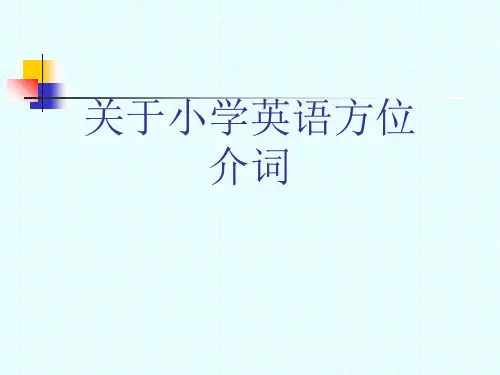
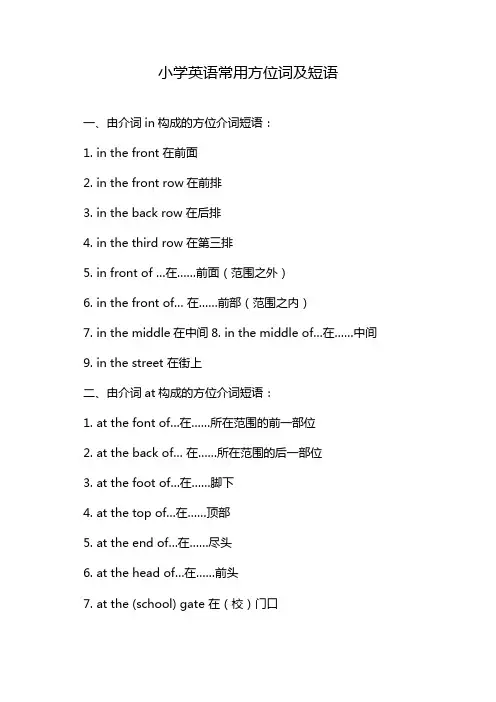
小学英语常用方位词及短语一、由介词in构成的方位介词短语:1. in the front 在前面2. in the front row在前排3. in the back row 在后排4. in the third row 在第三排5. in front of …在……前面(范围之外)6. in the front of…在……前部(范围之内)7. in the middle在中间8. in the middle of…在……中间9. in the street 在街上二、由介词at构成的方位介词短语:1. at the font of…在……所在范围的前一部位2. at the back of…在……所在范围的后一部位3. at the foot of…在……脚下4. at the top of…在……顶部5. at the end of…在……尽头6. at the head of…在……前头7. at the (school) gate 在(校)门口8. at the station 在车站9. at No. 2 Changan Road 在长安路2号10. at my uncle’s在我叔叔家11. at home 在家12. at the doctor’s在医务室/在诊所三、由介词on构成的方位介词短语:1. on the right / left 在右(左)边2. on one’s right / left 在某人的右(左)边3. on the desk / table 在课桌/桌上4. on the right–hand / left–hand side 在右/左手边5. on the blackboard 在黑板上6. on / in the wall 在墙上/里7. on the paper 在纸上四、由其它介词构成的方位介词短语:1. next to 靠近/贴近2. beside the desk 在课桌旁3. behind the door 在门后4. under the bed 在床下5. near the window 靠近窗户6. outside the gate 在门外7. between A and B 在A和B之间8. among the hills 在山中。
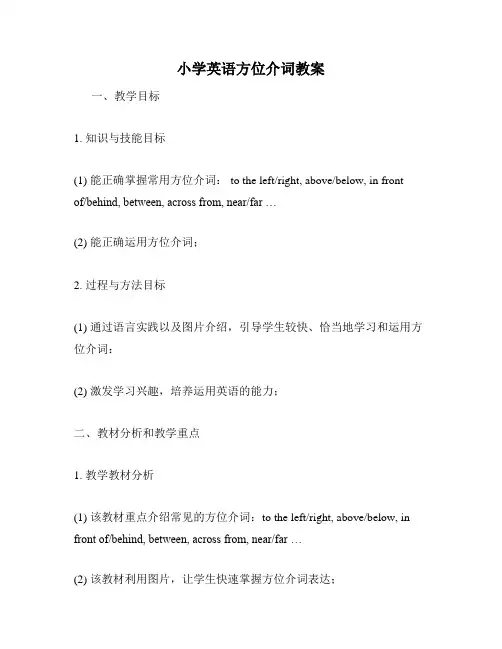
小学英语方位介词教案一、教学目标1. 知识与技能目标(1) 能正确掌握常用方位介词: to the left/right, above/below, in frontof/behind, between, across from, near/far …(2) 能正确运用方位介词;2. 过程与方法目标(1) 通过语言实践以及图片介绍,引导学生较快、恰当地学习和运用方位介词:(2) 激发学习兴趣,培养运用英语的能力;二、教材分析和教学重点1. 教学教材分析(1) 该教材重点介绍常见的方位介词:to the left/right, above/below, in front of/behind, between, across from, near/far …(2) 该教材利用图片,让学生快速掌握方位介词表达;2. 教学重点:(1) 掌握常用方位介词:to the left/right, above/below, in front of/behind, between, across from, near/far …(2) 运用正确的方位介词描述图片相关表达三、教学过程1. 新课导入:(1) 老师向学生介绍今天要学习的方位介词:T: Good morning, everyone. Today we are going to learn a new topic---prepositions of place. Do you know what is a preposition?Ss: A preposition is a word that shows the relationship between other words in a sentence.T: Very good. Now I’m going to show you some pictures to introduce the prepositions of place. Look at this one, can you tell me what preposition do you need to describe this picture?Ss: Above.2. 认识新词:(1) 设计词汇搭配游戏,使学生掌握几个常用的方位介词:T: Now I’m going to give you a game. I will show you the picture and you need to tell me the preposition of the place I'm pointing to.(2) 每个学生挑选以学过的方位介词为角色的卡通角色,对对方的角色或玩具进行描述,发现学过的方位介词并情景运用;T: Now let’s try a new game. Please choose the cartoon character withp reposition you’ve learned, then use the preposition to describe the other’s character or toys.3. 熟练操练:(1) 学生组成小组,在老师的带领下家家围住一个小物品,用学过的方位介词进行描述物品的位置;T: Now please group yourselves and gather round it. And try to use the prepositions to describe the place of the object.(2) 每一个小组一棵树为主题完整描述树的方位;T: I will give each group a tree and you need to work together to describe the place of the tree using the prepositions we have learnt.4. 产出课件:(1) 老师让每组组员手拿信封,用学过的方位介词介绍信封各个部分的位置;T: Now you can use the prepositions to describe the part of the envelope.(2) 如果掌握能力较强,可以在画本上根据老师口头提示画出一颗带着叶子的大树,描述树叶子位置时用学过的方位介词;T: If you master the prepositions, you can draw a big tree with leaves in your drawing book according to my instructions. When you describe the position of the leaves, please use the prepositions we have learnt.五、板书设计常用方位介词:to the left/rightabove/belowin front of/behindbetweenacross from near/far。

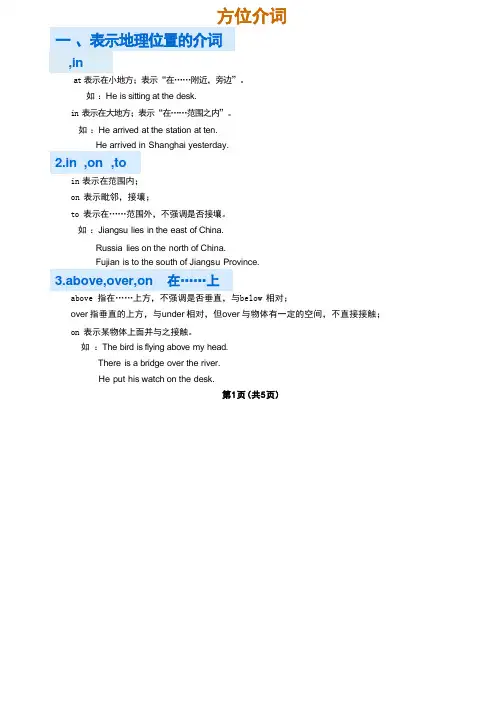
方位介词一、表示地理位置的介词,inat 表示在小地方;表示“在……附近,旁边”。
如:He is sitting at the desk.in 表示在大地方;表示“在……范围之内”。
如:He arrived at the station at ten.He arrived in Shanghai yesterday.2.in ,on ,toin 表示在范围内;on 表示毗邻,接壤;to 表示在……范围外,不强调是否接壤。
如:Jiangsu lies in the east of China.Russia lies on the north of China.Fujian is to the south of Jiangsu Province.3.above,over,on 在……上above 指在……上方,不强调是否垂直,与below 相对;over 指垂直的上方,与under 相对,但over 与物体有一定的空间,不直接接触;on 表示某物体上面并与之接触。
如:The bird is flying above my head.There is a bridge over the river.He put his watch on the desk.第1页(共5页)4.below,under 在……下面under表示在……正下方;below 表示在……下,不一定在正下方。
如:There is a cat under the table.Please write your name below the line.二、其它常用的介词1.between,amongbetween 指在两个人或两个事物之间;among 指在三个或三个以上的人或事物之间。
如:There is a football match between Class One and Class Two on the playground.The teacher is standing among the students.except 是指不包括后面所提人或物在内的“除了”,可以理解为“撇开……不谈”,表示两部分的不同。
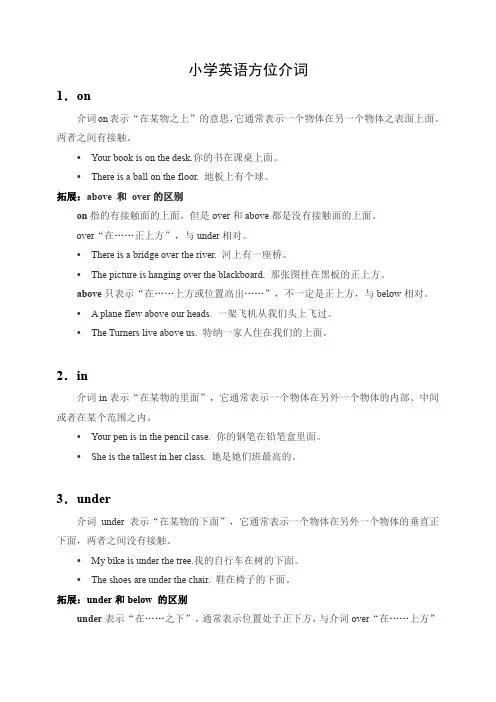
小学英语方位介词1.on介词on表示“在某物之上”的意思,它通常表示一个物体在另一个物体之表面上面。
两者之间有接触。
•Your book is on the desk.你的书在课桌上面。
•There is a ball on the floor. 地板上有个球。
拓展:above 和over的区别on指的有接触面的上面,但是over和above都是没有接触面的上面。
over“在……正上方”,与under相对。
•There is a bridge over the river. 河上有一座桥。
•The picture is hanging over the blackboard. 那张图挂在黑板的正上方。
above只表示“在……上方或位置高出……”,不一定是正上方,与below相对。
• A plane flew above our heads. 一架飞机从我们头上飞过。
•The Turners live above us. 特纳一家人住在我们的上面。
2.in介词in表示“在某物的里面”,它通常表示一个物体在另外一个物体的内部、中间或者在某个范围之内。
•Your pen is in the pencil case. 你的钢笔在铅笔盒里面。
•She is the tallest in her class. 她是她们班最高的。
3.under介词under表示“在某物的下面”,它通常表示一个物体在另外一个物体的垂直正下面,两者之间没有接触。
•My bike is under the tree.我的自行车在树的下面。
•The shoes are under the chair. 鞋在椅子的下面。
拓展:under和below 的区别under表示“在……之下”,通常表示位置处于正下方,与介词over“在……上方”相对应。
•There is a book under the table.桌子下面有一本书。
• A cat is sitting under the table.一只猫在桌子下面。
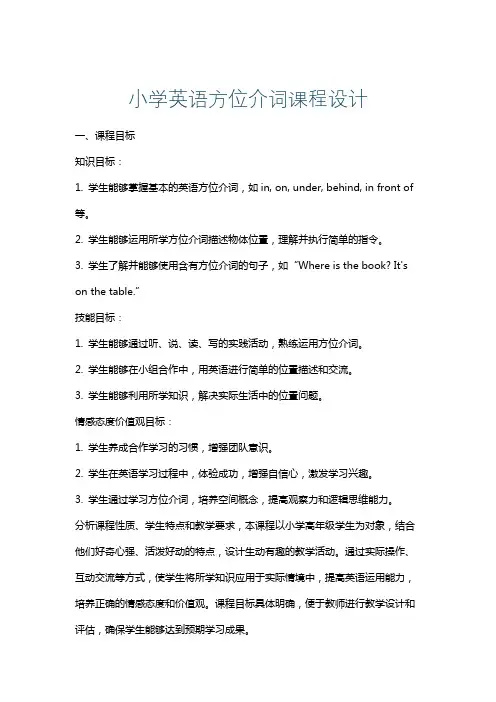
小学英语方位介词课程设计一、课程目标知识目标:1. 学生能够掌握基本的英语方位介词,如in, on, under, behind, in front of 等。
2. 学生能够运用所学方位介词描述物体位置,理解并执行简单的指令。
3. 学生了解并能够使用含有方位介词的句子,如“Where is the book? It's on the table.”技能目标:1. 学生能够通过听、说、读、写的实践活动,熟练运用方位介词。
2. 学生能够在小组合作中,用英语进行简单的位置描述和交流。
3. 学生能够利用所学知识,解决实际生活中的位置问题。
情感态度价值观目标:1. 学生养成合作学习的习惯,增强团队意识。
2. 学生在英语学习过程中,体验成功,增强自信心,激发学习兴趣。
3. 学生通过学习方位介词,培养空间概念,提高观察力和逻辑思维能力。
分析课程性质、学生特点和教学要求,本课程以小学高年级学生为对象,结合他们好奇心强、活泼好动的特点,设计生动有趣的教学活动。
通过实际操作、互动交流等方式,使学生将所学知识应用于实际情境中,提高英语运用能力,培养正确的情感态度和价值观。
课程目标具体明确,便于教师进行教学设计和评估,确保学生能够达到预期学习成果。
本章节教学内容以人教版小学英语教材中方位介词为主题,结合课程目标,进行以下组织和安排:1. 引入方位介词概念:通过图片展示、实际操作等方式,使学生了解和感知方位介词的基本含义,如in, on, under, behind, in front of等。
2. 教学大纲:a. 方位介词的定义与用法:讲解各个方位介词的含义,并通过实例演示如何运用这些介词描述物体位置。
b. 实践活动:设计听、说、读、写四个方面的实践活动,让学生在实际语境中运用方位介词。
c. 句子练习:结合方位介词,教授如何构造简单的位置描述句子,如“Where is the book? It's on the table.”3. 教学内容安排:a. 第一节课:引入方位介词概念,学习in, on, under三个介词。
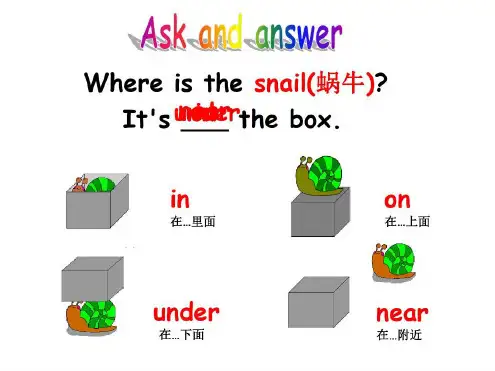

三一文库()/小学一年级〔小学英语语法方位介词辨析[1]〕1. at, in, onat 一般指小地方;in 一般指大地方或某个范围之内;on 往往表示“在某个物体的表面”。
例如:He arrived in Shanghai yesterday. 他昨天到上海。
They arrived at a small village before dark. 他们在天黑前到达一个小村庄。
There is a big hole in the wall. 墙上有个大洞。
The teacher hung a picture on the wall. 老师把一幅画挂在墙上。
2. over, above, onover, on 和 above 都可表示“在……上面”,但具体含义不同。
Over 表示位置高于某物,在某物的正上方,其反义词是under。
above 也表示位置高于某物,但不一定在正上方,其反义词是below。
On 指两个物体表面接触,一个在另一的上面。
例如:There is a bridge over the river. 河上有一座桥。
We flew above the clouds. 我们飞越云层。
They put some flowers on the teacher's desk. 他们把一些花放在讲桌上。
3. across, throughacross 和 through 均可表示“从这一边到另一边”,但用法不同。
Across 的含义与 on 有关,表示动作在某一物体的表面进行。
Through 的含义与 in 有关,表示动作是在三维空间进行。
例如:The dog ran across the grass. 狗跑过草地。
The boy swam across the river. 那男孩游过河。
They walked through the forest. 他们穿过森林。
I pushed through the crowds. 我挤过人群。
小学英语方位介词顺口溜小学英语方位介词顺口溜 1口诀1年月周前要用in,日子前面却不行。
遇到几号要用on,上午下午又是in。
要说某日上下午,用on换in才能行。
午夜黄昏用at,黎明用它也不借。
at也在时分前,说“差”用to,说“过”要用part。
口诀2in在……里, out在……外,在旁边的是beside,靠近的为by 。
on在……上,under在……下, above在上头, below在底下。
口诀3this、that、tomorrow,yesterday,next、last、one。
年、月、季、周、周之后,介词省略已经习以为常。
over、under正上下,above、below则不然,若与数量词连用,混合使用亦无关。
beyond超出、无、不能,against靠着,对与反。
besides,except分内外,among之内along沿。
同类比较except,加for异类记心间。
口诀4before、after表一点, ago、later表一段。
before能接完成时,ago过去极有限。
since以来during间,since时态多变换。
与之相比beside,除了last but one。
口诀5①早、午、晚要用in 例:in the morning 在早上in the afternoon 在下午in the evening 在晚上in the day 在白天②黎明、午、夜、点与分用at例:at dawn, at daybreak 在黎明时候atnoon 在中午at night 在夜间at midnight 在午夜atsix o‘clock 在6点钟at 7:30 (seven thirty) 在7点半at half past eleven 在11点半at nine fif 在9点15分 at ten thirty a.m. 在上午10点30分at the weekend 在周末③年、月、年月、季节、周用in。